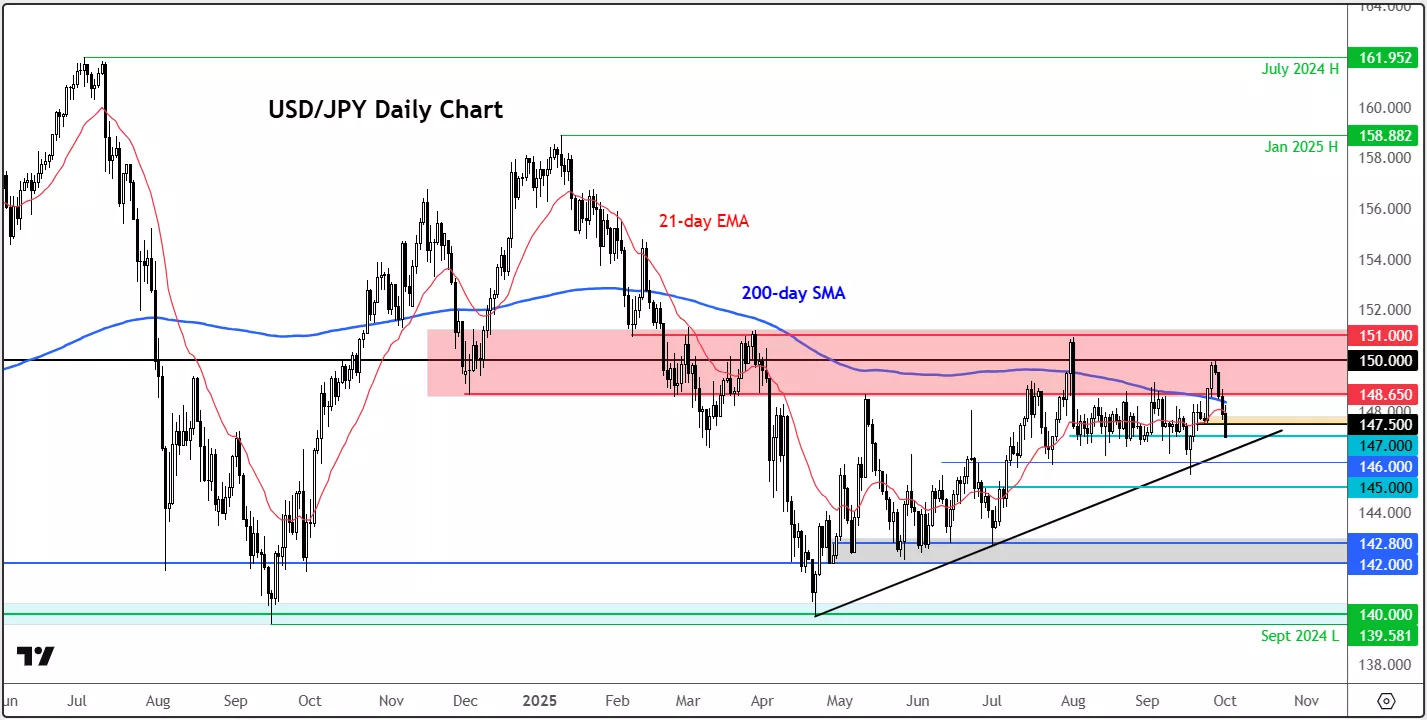USD/JPY Forecast: Dollar Takes A Tumble As Government Shutdown
Image Source: Unsplash
The US dollar index has come under pressure this week, with the yen emerging as one of the strongest performers across the FX market. The latest leg lower in USD has been fuelled in part by falling US bond yields, while a slide in oil prices, which tends to benefit energy importers like Japan, has also helped to support the yen. But more to the point, it is the US government shutdown which is keeping the dollar under pressure across the board. Markets are now weighing up the prospect of an extended stalemate, which could sap consumer confidence and deepen concerns over job security.
Dollar faces uncertainty from both Washington and data
The US dollar index has been edging lower in recent days with traders keeping one eye on the budget standoff in Washington. Overnight, the greenback took another knock, slipping in the wake of Washington’s failure to avert a government shutdown. Truth be told, this was mostly expected but the fact that it has happened means there would be delay for the release of critical jobs data this week, leaving the Fed flying blind on the labour market. Consequently, any near-term dollar recovery attempts could be faded.
Rate expectations have already shifted. Traders are pricing around two rate cuts by year-end and over 100 basis points by 2026. This is still slightly less than what markets expected earlier this month. That repricing reflects a tug-of-war between an improving near-term US data pulse and lingering doubts over labour market strength. The means that the risks are tilted to further downside for the dollar in the event of data disappointment this week.
ADP and ISM manufacturing to come
We should still get to see today’s ADP private payrolls reports and ISM manufacturing PMI. But the weekly jobless claims data and September’s payroll report, which were due for release on Thursday and Friday, are now unlikely to be released on schedule.
The ADP employment report is expected around +50K, which would be on par with the prior reading. The ISM manufacturing print is expected to remain just below the 50.0 mark. Markets will watch the prices paid component closely, but tariff-driven inflation hasn’t been a major issue yet with the Fed and many other forecasters expecting it to be temporary on the assumption that a softer labour and housing trends should push services inflation lower anyway. That combination keeps the door open for the Fed to cut rates again, both in October and December.
Consumer confidence drops
Yesterday, the focus was on the JOLTS job openings data, with expectations for little change. However, it showed a bit of improvement to 7.23m from 7.18m the month before. Nonetheless, the US dollar fell further, possibly because of shutdown fears and the fact that the day’s other data releases were soft. Indeed, the Conference Board’s consumer confidence figures, which were seen ticking lower, were confirmed, but the drop was bigger than expected at 94.2 vs. 96.0 eyed and 97.8 previous. On top of this, the Chicago PMI disappointed at 40.6 vs. 43.3 expected, and down from 41.5 previously.
Yen finds tailwinds
The Japanese yen appears to be the primary beneficiary of the latest government shutdown which officially began overnight, and hopes of a quick resolution appear slim. The USD/JPY has dropped to 147.00 handle. Democrats appear to be bracing for a longer fight, positioning themselves as defenders of healthcare ahead of next year’s mid-terms, while Republicans, with control of the congressional agenda and the backing of the White House, show little appetite to compromise.
The main concern here is that with an already-weakening consumer confidence and a gloomier jobs outlook, the shutdown could exacerbate these trends if it last more than just a few days. If President Trump follows through on threats to dismiss non-essential staff, then as many as 150,000 layoffs could distort upcoming payroll data, with October’s NFP in particular at risk. In the meantime, regular economic reporting will also be disrupted.
While the dollar struggles, the yen is quietly gaining across the board. The GBP/JPY, for example, has slipped to 198.00 after failing to hold the psychological 200.00 level and amid budget uncertainty in the UK, while the CAD/JPY is under pressure as oil prices extend their slide since the start of the week. What’s more, the Bank of Japan has signalled it is edging towards tightening, while the Fed is moving in the opposite direction with cuts already in play. That means bond yield differential could narrow further in the favour of the yen, potentially creating a bearish USD/JPY trend.
USD/JPY technical analysis and levels to watch
(Click on image to enlarge)

From a technical perspective, the USD/JPY chart is starting to show a few bearish signs again after being neutral for much of the summer. The pair has been choppy for months—flat in June, higher in July, lower in August, and then bouncing in early September. In the last few days, however, sellers have regained the upper hand, threatening to end a four-week winning streak.
The key level to watch is 147.50, which has now been taken out. A break below here has already sparked a wave of stop-loss selling, with the first objective of 147.00 now being met. Should rates now hold below 147.50, then this could potentially open the path towards 146.30, 146.00 and possibly 145.00 in the near-term.
Meanwhile, immediate resistance is now seen at 147.50, then above that it is layered between 148.50–148.65, followed by the big psychological 150.00.
More By This Author:
Gold Eases Back After Hitting Yet New Highs – What’s Next?
Dollar And USD/JPY Analysis
Crude Oil Could Break Lower




